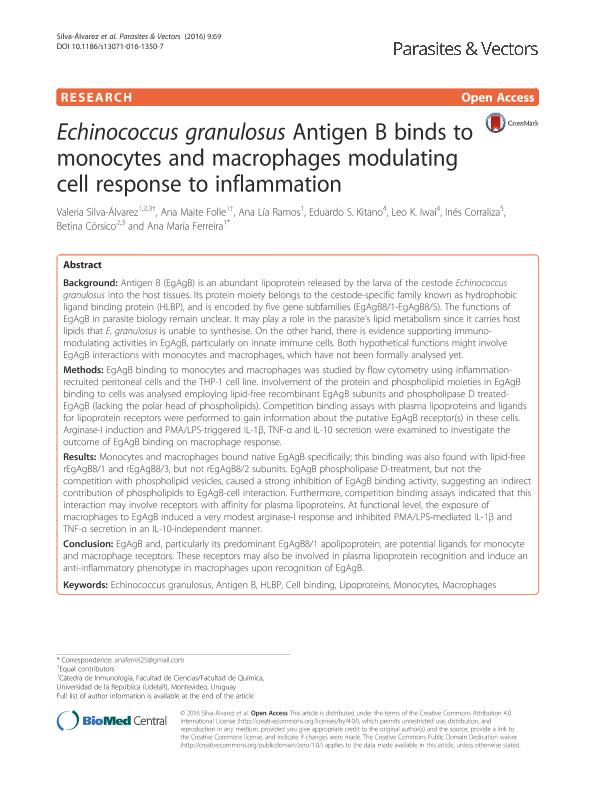Mostrar el registro sencillo del ítem
dc.contributor.author
Silva Álvarez, Valeria
dc.contributor.author
Folle, Ana Maite
dc.contributor.author
Ramos, Ana Lía
dc.contributor.author
Kitano, Eduardo S.
dc.contributor.author
Iwai, Leo K.
dc.contributor.author
Corraliza, Ines
dc.contributor.author
Córsico, Betina

dc.contributor.author
Ferreira, Ana María
dc.date.available
2018-06-15T19:27:36Z
dc.date.issued
2016-02
dc.identifier.citation
Silva Álvarez, Valeria; Folle, Ana Maite; Ramos, Ana Lía; Kitano, Eduardo S.; Iwai, Leo K.; et al.; Echinococcus granulosus Antigen B binds to monocytes and macrophages modulating cell response to inflammation; BioMed Central; Parasites and Vectors; 9; 69; 2-2016; 1350-1357
dc.identifier.issn
1756-3305
dc.identifier.uri
http://hdl.handle.net/11336/48855
dc.description.abstract
Background: Antigen B (EgAgB) is an abundant lipoprotein released by the larva of the cestode Echinococcusgranulosus into the host tissues. Its protein moiety belongs to the cestode-specific family known as hydrophobicligand binding protein (HLBP), and is encoded by five gene subfamilies (EgAgB8/1-EgAgB8/5). The functions ofEgAgB in parasite biology remain unclear. It may play a role in the parasite?s lipid metabolism since it carries hostlipids that E. granulosus is unable to synthesise. On the other hand, there is evidence supporting immunomodulatingactivities in EgAgB, particularly on innate immune cells. Both hypothetical functions might involveEgAgB interactions with monocytes and macrophages, which have not been formally analysed yet.Methods: EgAgB binding to monocytes and macrophages was studied by flow cytometry using inflammationrecruitedperitoneal cells and the THP-1 cell line. Involvement of the protein and phospholipid moieties in EgAgBbinding to cells was analysed employing lipid-free recombinant EgAgB subunits and phospholipase D treatedEgAgB(lacking the polar head of phospholipids). Competition binding assays with plasma lipoproteins and ligandsfor lipoprotein receptors were performed to gain information about the putative EgAgB receptor(s) in these cells.Arginase-I induction and PMA/LPS-triggered IL-1β, TNF-α and IL-10 secretion were examined to investigate theoutcome of EgAgB binding on macrophage response.Results: Monocytes and macrophages bound native EgAgB specifically; this binding was also found with lipid-freerEgAgB8/1 and rEgAgB8/3, but not rEgAgB8/2 subunits. EgAgB phospholipase D-treatment, but not thecompetition with phospholipid vesicles, caused a strong inhibition of EgAgB binding activity, suggesting an indirectcontribution of phospholipids to EgAgB-cell interaction. Furthermore, competition binding assays indicated that thisinteraction may involve receptors with affinity for plasma lipoproteins. At functional level, the exposure ofmacrophages to EgAgB induced a very modest arginase-I response and inhibited PMA/LPS-mediated IL-1β andTNF-α secretion in an IL-10-independent manner.Conclusion: EgAgB and, particularly its predominant EgAgB8/1 apolipoprotein, are potential ligands for monocyteand macrophage receptors. These receptors may also be involved in plasma lipoprotein recognition and induce ananti-inflammatory phenotype in macrophages upon recognition of EgAgB.
dc.format
application/pdf
dc.language.iso
eng
dc.publisher
BioMed Central

dc.rights
info:eu-repo/semantics/openAccess
dc.rights.uri
https://creativecommons.org/licenses/by-nc-sa/2.5/ar/
dc.subject
Echinococcus
dc.subject
Antigenob
dc.subject
Monocito
dc.subject
Inflamacion
dc.subject.classification
Parasitología

dc.subject.classification
Ciencias de la Salud

dc.subject.classification
CIENCIAS MÉDICAS Y DE LA SALUD

dc.title
Echinococcus granulosus Antigen B binds to monocytes and macrophages modulating cell response to inflammation
dc.type
info:eu-repo/semantics/article
dc.type
info:ar-repo/semantics/artículo
dc.type
info:eu-repo/semantics/publishedVersion
dc.date.updated
2018-06-14T19:05:40Z
dc.journal.volume
9
dc.journal.number
69
dc.journal.pagination
1350-1357
dc.journal.pais
Reino Unido

dc.journal.ciudad
Londres
dc.description.fil
Fil: Silva Álvarez, Valeria. Universidad de la República; Uruguay. Consejo Nacional de Investigaciones Científicas y Técnicas. Centro Científico Tecnológico Conicet - La Plata. Instituto de Investigaciones Bioquímicas de La Plata "Prof. Dr. Rodolfo R. Brenner". Universidad Nacional de la Plata. Facultad de Ciencias Médicas. Instituto de Investigaciones Bioquímicas de La Plata ; Argentina
dc.description.fil
Fil: Folle, Ana Maite. Universidad de la República; Uruguay
dc.description.fil
Fil: Ramos, Ana Lía. Universidad de la República; Uruguay
dc.description.fil
Fil: Kitano, Eduardo S.. Governo do Estado de Sao Paulo. Secretaria da Saude. Instituto Butantan; Brasil
dc.description.fil
Fil: Iwai, Leo K.. Governo do Estado de Sao Paulo. Secretaria da Saude. Instituto Butantan; Brasil
dc.description.fil
Fil: Corraliza, Ines. Universidad de Extremadura; España
dc.description.fil
Fil: Córsico, Betina. Consejo Nacional de Investigaciones Científicas y Técnicas. Centro Científico Tecnológico Conicet - La Plata. Instituto de Investigaciones Bioquímicas de La Plata "Prof. Dr. Rodolfo R. Brenner". Universidad Nacional de la Plata. Facultad de Ciencias Médicas. Instituto de Investigaciones Bioquímicas de La Plata ; Argentina
dc.description.fil
Fil: Ferreira, Ana María. Universidad de la República; Uruguay
dc.journal.title
Parasites and Vectors

dc.relation.alternativeid
info:eu-repo/semantics/altIdentifier/doi/https://dx.doi.org/10.1186/s13071-016-1350-7
dc.relation.alternativeid
info:eu-repo/semantics/altIdentifier/url/https://parasitesandvectors.biomedcentral.com/articles/10.1186/s13071-016-1350-7
Archivos asociados
